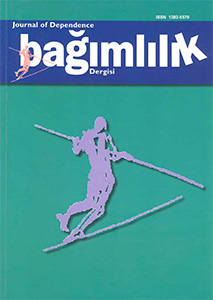Investigation of documents of healthcare professionals who was treated in a university hospital because of alcohol/substance usage problem
Keywords:
Healthcare professionals, physicians, nurses, alcohol use, substance useAbstract
Objective: In this study, it was aimed to investigate registration ways, some demographical variables and substance use characteristics of healthcare professionals who was treated as inpatient and outpatient because of alcohol or substance use.
Method: The sample consists of 77 healthcare professionals who were 87% of inpatients (n=67) and 10% of outpatients (n=10) about alcohol abuse problem as at the Ankara University Psychiatry Clinic between October 1994 and March 2007. Demographical variables, abused substances and application styles were determined by analyzing patients files. Also numbers and percentages about these variables were determined. Alcohol/substance use as a sex and working conditions were compared by the chi-square test.
Results: Healthcare professionals were 6.7 % of 1004 patients who were treated as inpatients in emphasized period. Subjects were composed of 20.8 % of women (n=16) and 79.2 % of men (n=61) and they were applied about 63.6 % of alcohol, 26.0 % of only substance use and 10.4 % of alcohol with substance use problem. 47.2 % of physicians have alcohol use problem, 33.3 % have substance use problem and 19.4 % have both alcohol and substance use problem. Working in a surgical section increases the risk of using a substance other than alcohol. Healthcare professionals who are working in primary, secondary referral centers and university hospitals have higher risks of alcohol and substance use than healthcare professionals who are not working these referral centers and hospitals.(x2=7.862, sd=2, p<0.05). Most applications were made self willingly.
Conclusion: Alcohol, opiates and benzodiazepines were most fenquently used substances among healthcare professionals. For this reason, prevention and treatment stages are important especially to decrease of frequency of substance use among health care professionals. Concrete steps should be more prevalent.
References
Brewster JM. Prevalence of alcohol and other drug problems among physicians. JAMA 1986; 255:1913-1920.
Kumar P, Basu D. Substance abuse by medical students and doctors. J Indian med Assoc 2000;98:447-452.
Baldisseri MR. Impaired healthcare professional. Crit Care Med 2007; 35:106-116.
Ritson EB. Alcohol, drugs and stigma. Int J Clin Pract 1999; 53:549-551.
JanecekE,MarshmanJA,BreusterJM.Drugproblems among healthprofessionals. CPJ 1989; 122:130-134.
Griffith J. Substance abuse disorders in nurses. Nurs Forum 1999; 34:19-28.
Fletcher CE. Michigan’s unique approach to treating impaired health care professionals. J Addict Dis 2001; 20: 97-111.
O’Conner PG, Spickard A. Physician impairment by substance abuse. Med Clin North Am 1997; 81:1037-1052.
Weir E. Substance abuse among physicians. CMAJ 2000; 162: 1730.
Akvardar Y, Aslan B, Ekici ZB ve ark. Dokuz Eylül Üniversitesi Tıp Fakültesi dönem II öğrencilerinde sigara, alkol, madde kullanımı. Bağımlılık Dergisi 2001;2: 49-52.
Akvardar Y, Demiral Y, Ergör G ve ark. Substance use among medical students and physicians in a medical school in Turkey. Soc Psychiatr Epidemiol 2004; 39: 502-506.
Akvardar Y, Türkcan A, Çakmak D. Doktorlar arasında madde kötüye kullanımı bir sorun mu? Türk Psikiyatri Dergisi 2002; 13:238-244.
Evren E, Ögel K, Çakmak D. Esrar ve meperidin kullanım bozukluğu nedeni ile yatarak tedavi gören hastaların özelliklerinin karşılaştırılması. Anadolu Psikiyatri Dergisi 2002; 3:20-27.
Köse MB. Denizli il merkezindeki hastanelerde çalışan hemşirelerde psikoaktif madde kullanımı. Pamukkale Üniversitesi Sağlık Bilimleri Enstitüsü Halk Sağlığı Hemşireliği Anabilim Dalı. Yayınlanmamış Yüksek Lisans Tezi, 2001, Denizli.
Khantzian EJ. The self-medication hypothesis of addictive disorders: focus on heroin and cocaine dependence. Am J Psychiatry 1985; 142:1259-1264.
Green P. The chemically dependent nurse. Nurs Clin North Am 1989; 24:81-94.
Gualtieri AC, Cosentino JP, Becker JJ. The California experience with the diversion program for impaired physicians. JAMA 1983; 249:226-229.
Meyer R, Whitehead F. Chemically dependent medical practitioners-the prognosis for treatment. S Aft Med J 1999; 89:1239-1240.
Kılıç C, Erol N, Ulusoy M ve ark. Türkiye Ruh Sağlığı Profili ön rapor-erişkin nüfusla ilgili sonuçlar. Sağlık Bakanlığı, Ankara: Aydoğan Ofset, 1997.34-42.
Ganley OH, Perdergast WJ, Wilkerson MW, et al. Outcome study of substance impaired physicians and physician assistants under contact with North Carolina Physicians Health Program for the period 1995-2000. J Addict Dis 2005; 24:1-12.
Gossop M, Stephens S, Stewart D, et al. Health care professionalsreferredfortreatmentofalcoholand drug problems. Alcohol Alcohol 2001; 36:160-164.
Beaujouan L, Czernichow S, Pourriat JL, et al. Prevalence and risk factors for substance abuse and dependence among anaesthetists. a national survey. Ann F Anesth Reanim 2005; 24:471-479.
Kintz P, Villain M, Dumetre V, et al. Evidence of addiction by anesthesiologists as ducumented by hair analysis. Forensic Sci Int 2005;153:81-84.
Centon-Guinan Mary J, Waite Lucille M. The director of nursing and the chemically dependent nurse. Nurs Manage 1991; 22:52-54.
Chi J. How Pharmacits cope with stress. Drug Topics 1982; 126:26-30.
Kenna GA, Wood MD. The prevalence of alcohol, cigarette and illicit drug use and problems among dentists. J Am Dent Assoc 2005; 13:1023-1032.
Domino KB, Hornbein TB, Polissar NL et al. Risk fac-torsforrelapseinhealthcareprofessionalswithsu-bstance use disorders. JAMA 2005; 293:1513-1515.
Sayıl I, Haran S, Ölmez Ş ve ark. Ankara Üniversitesi hastanelerinde çalışan doktor ve hemşirelerin tükenmişlik düzeyleri. Kriz Dergisi 1997; 5:71-78.
Downloads
Published
Issue
Section
License
Copyright (c) 2025 Journal of Dependence

This work is licensed under a Creative Commons Attribution-NonCommercial-NoDerivatives 4.0 International License.
The Journal and content of this website is licensed under the terms of the Creative Commons Attribution-NonCommercial-NoDerivatives 4.0 International (CC BY-NC-ND 4.0) License. This is in accordance with the Budapest Open Access Initiative (BOAI) definition of open access. The Creative Commons Attribution-NonCommercial-NoDerivatives 4.0 International (CC BY-NC-ND 4.0) allows users to copy, distribute and transmit unmodified article, and make noncommercial use of the article. The CC BY license permits non-commercial re-use of an open access article, as long as the author is properly attributed.

